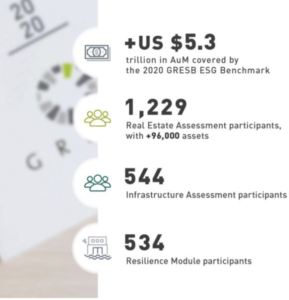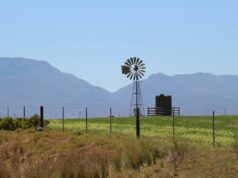INSIGHT by GRESB
We’re excited to announce that participation in the GRESB Assessments has grown by 18% this year to cover the ESG performance of more than 1,700 real estate and infrastructure portfolios and assets. This increase comes despite the pressures of the Covid-19 pandemic and is testament to an industry-wide commitment to ESG transparency and collaborative action on sustainability.

| The 2020 ESG benchmark now covers more than US $5.3 trillion AuM (2019: 4.5 trillion), giving clarity and direction to the real asset investment market as a means to address complex sustainability challenges. GRESB data is used by hundreds of capital providers and thousands of asset managers to benchmark investments across portfolios and understand the opportunities, risks and choices that need to be made as the industry transitions to a more sustainable future.
The benchmarks also provide an objective reference point on national and regional performance and help to track industry progress against normative guidelines such as the UN Sustainable Development Goals; decarbonization pathways such as those defined by Carbon Risk Real Estate Monitor (CRREM) for the real estate sector and emerging disclosure regulations including the Financial Stability Board’s Task Force on Climate-related Financial Disclosures (TCFD), and the EU ESG Regulations.
| 2020 Real Estate Coverage
1,229 (2019: 1,005) property companies, REITs, private equity funds and real estate developers participated in the 2020 Real Estate Assessment, generating a benchmark that covers US $4.8 trillion AuM (2019: 4.1 trillion). Data on key environmental performance indicators is reported at asset level and covers more than 96,000 assets, across 64 countries. The data combines high-level overall scores with in-depth information across hundreds of ESG metrics, including performance indicators such as energy consumption, GHG emissions, water consumption and waste.
For private market investors, the GRESB benchmark covers 957 (2019: 723) non-listed funds, representing 79 of IPE Real Assets’ Top 100 Global Real Estate Investment Managers who participate with at least one fund and 46 of PERE 100: institutional capital’s top manager picks.
The listed dataset covers 272 (2019: 240) publicly-traded property companies and REITs globally, representing 61% coverage of the major developed listed real estate indices. Adding the GRESB Public Disclosure Dataset results in full coverage of the major listed real estate indices.
| 2020 Infrastructure Coverage
The Infrastructure Fund Assessment increased by 10% to cover 118 funds (2019: 107) and the Infrastructure Asset Assessment grew by 8% to include 426 assets (2019: 393). The Infrastructure Benchmark now represents US $576 billion AuM (2019: 471 billion), covering 32 of the 34 industry sectors across 40 countries.
To add market context to these numbers, 32% of IPE Real Assets’ Top 100 Infrastructure Investment Managers, and 38% of the Infrastructure Investor Top 50 participate in the Infrastructure Fund Assessment, with at least one portfolio or asset. And the Infrastructure Public Disclosure dataset has full coverage of the GLIO Global Coverage Index (170 listed infrastructure companies with a US $2.7 trillion total market cap).
| 2020 Resilience Coverage
534 entities (comprising 408 real estate entities, 98 infrastructure assets, and 28 infrastructure funds) participated in the Resilience Module, a 69% increase from the previous year. This year marks the third and final year of the Resilience Module as a voluntary supplement for the Real Estate and Infrastructure Assessments. In 2021 the Resilience Module will be integrated into the core Assessments forming part of the required reporting set.
The Module indicators, in coordination with the core Assessments, cover all TCFD recommendations helping investors to identify, assess, and manage climate-related risks and resilience efforts across real asset companies and funds around the world.
| ESG data that changes an industry
The transition to a sustainable real asset industry is one of the most fundamental challenges we face. It can only be met with reliable ESG information, meaningful global benchmarks and collective action from all stakeholders working towards a sustainable future. We hope you will join us for our online Public Results Events taking place the week beginning November 9, 2020, and thank you for being part of the movement.
Congratulations to all 2020 GRESB Participants
“With accelerating sustainability risks, accessing standardized and reliable ESG data and benchmarks has never been more important to investors,” said Sander Paul van Tongeren, Co-founder and Managing Director at GRESB. “It’s inspiring to witness the collective industry effort from around the world to improve ESG transparency and advance sustainable real assets.”
“We also owe a great debt to current and past members of the GRESB Board of Directors, along with our Advisory Boards, Regional Benchmark Committees and Industry Working Groups without whom the GRESB Assessments and benchmarks would not have achieved the industry standing they enjoy today.”
| about
GRESB is a mission driven and investor led organization providing standardized and validated Environmental, Social and Governance (ESG) data to the capital markets. Established in 2009, GRESB has become the leading ESG benchmark for real estate and infrastructure investments across the world. The reported ESG data covers US $5.3 trillion AuM and is used by more than 100 institutional and financial investors to benchmark investments across portfolios and understand the opportunities, risks and choices that need to be made as the industry transitions to a more sustainable future. The benchmark is supported by an engaged community of managers who participate in the annual reporting process and a group of inspirational industry associations, data partners and ESG service providers all working towards a shared vision of sustainable real assets.








